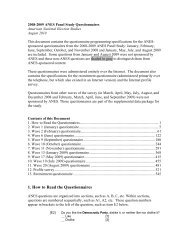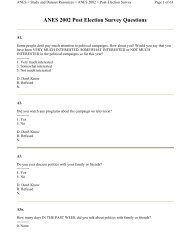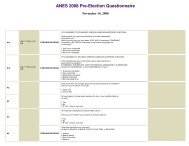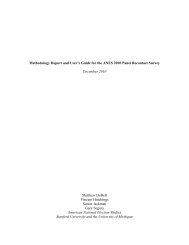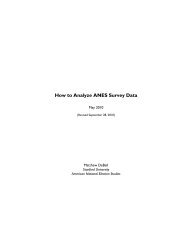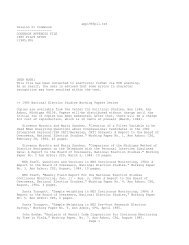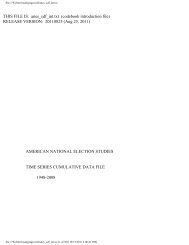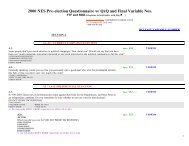The Application of Concept Mapping to Text Analysis: Examples and ...
The Application of Concept Mapping to Text Analysis: Examples and ...
The Application of Concept Mapping to Text Analysis: Examples and ...
Create successful ePaper yourself
Turn your PDF publications into a flip-book with our unique Google optimized e-Paper software.
What you really want <strong>to</strong> know is that there is an abortion cluster <strong>and</strong> there is a death penalty cluster.<br />
<strong>The</strong> rule I use there is that I leave 20% <strong>of</strong> the <strong>to</strong>tal in. I have never been asked <strong>to</strong> justify the 20%. <strong>The</strong><br />
way that I think about it comes from the literature on affirmative action. For example, they find that 1 in<br />
5 or 20% is the point <strong>of</strong> optimal distinctiveness. <strong>The</strong> other rule <strong>of</strong> thumb is <strong>to</strong> use is a minimum – for<br />
example, if in one category I take only leave10 statements– I always leave the same minimum <strong>of</strong> all the<br />
rest <strong>of</strong> the categories. That is one way <strong>to</strong> get around the scaling-up problem (<strong>to</strong> avoid cognitive<br />
overload in sorters).<br />
Here is an example response that I broke in<strong>to</strong> 2 units. <strong>The</strong> key here is that if you leave more than one<br />
idea in a unit it is almost impossible <strong>to</strong> sort in<strong>to</strong> a discrete pile – <strong>and</strong> in terms <strong>of</strong> multidimensional<br />
scaling, you get a junk cluster in the middle. Unitizing is very, very critical. <strong>The</strong> way I do it, usually it is a<br />
very time consuming process. <strong>The</strong> whole analysis would probably take a couple <strong>of</strong> hours but the<br />
unitizing takes a couple <strong>of</strong> days depending on how many statements you have. I usually have 2<br />
researchers make the unitizing decisions <strong>and</strong> then access inter-coder reliability. Or we have also very<br />
successfully used a group <strong>of</strong> participants who generated statements – 3 or 4 <strong>of</strong> them get <strong>to</strong>gether <strong>and</strong><br />
make collective decisions about what constitutes units. I have done that on interview transcripts <strong>and</strong> on<br />
open-ended question surveys. It depends on how much <strong>of</strong> the participant judgment you want <strong>to</strong> retain<br />
<strong>and</strong> what you think your reviewers will think about the validity.<br />
<strong>The</strong> second step is <strong>to</strong> sort. Here is a hypothetical sort <strong>of</strong> 10 cards. <strong>The</strong> sorters that I choose are usually<br />
the original participants. Sometimes there are confidentiality issues so I can’t use original participants<br />
because for some reason they can identify – in the MBA section – who said what about who. We<br />
remove all the names <strong>and</strong> company references – I usually use the original participants, a minimum <strong>of</strong><br />
10, but I like <strong>to</strong> get about 24. If you can’t use original participants we have what we call proxies. <strong>The</strong><br />
criteria we use in identifying proxies are how much <strong>of</strong> the original experience do they share in terms <strong>of</strong><br />
the validity <strong>and</strong> the interpretation. If they use words that they don’t underst<strong>and</strong> the context <strong>of</strong> the words,<br />
the meaning, then it is very difficult <strong>to</strong> run a sort in the same way that would reflect the original structure<br />
from the participants. <strong>The</strong> second is how much knowledge <strong>of</strong> theory they have. When I was talking<br />
about what conflicts they have on their teams, I had the challenge <strong>of</strong> after a certain point they get an inclass<br />
module on managing conflict. In which case they would reflect the dominant <strong>to</strong>pologies that we<br />
teach <strong>and</strong> the structure wouldn’t necessarily emerge from their perspective. I had <strong>to</strong> make sure I used<br />
people that hadn’t had that theoretical background. That is where my research interest was. <strong>The</strong> third<br />
was how much existing theoretical frameworks can guide your interpretation <strong>of</strong> what they are doing So<br />
for example, in team management we know typically there is a task side <strong>and</strong> a social side. You manage<br />
the task <strong>and</strong> you manage the people where you work. You use those taxonomies <strong>to</strong> underst<strong>and</strong> how<br />
much the sorters are completely blind or how much they do know what they are doing. You can identify<br />
people who aren’t following instructions or aren’t taking the sort seriously. Here is a hypothetical sort –<br />
the instructions are <strong>to</strong> create as many piles as you think conceptually makes sense. It is not queue sort<br />
with forced distribution. <strong>The</strong> only rule that they have is that they can’t create a junk pile. If they don’t’<br />
think a statement belongs in a pile they leave it in its own pile <strong>and</strong> give it a name. When we aggregate<br />
by adding <strong>to</strong>gether all the sorter’s initial matrices—the result is a point map, where the collective (or<br />
aggregate) judgment decides where that point goes on the map. <strong>The</strong> sorters have labeled each <strong>of</strong> their<br />
piles. For this one – 6, 2, 1 & 9 go <strong>to</strong>gether so we create a binary score matrix for each <strong>of</strong> the sorters. In<br />
the database this matrix shows what the piles were <strong>and</strong> each <strong>of</strong> their piles is associated with a label.<br />
<strong>The</strong>n we aggregate just by adding all the matrixes <strong>to</strong>gether. You get an aggregate <strong>and</strong> you do an MDS<br />
on that, an aggregated matrix <strong>and</strong> you get an aggregated picture <strong>of</strong> your relationships between the<br />
statements <strong>and</strong> the units.<br />
I’ll show you a few examples <strong>of</strong> what the statements were so you can see how they fit <strong>to</strong>gether.<br />
[Pointing <strong>to</strong> slide] “Conflict on the best way <strong>of</strong> solving a problem”; “we didn’t know how <strong>to</strong> organize or<br />
approach the work;” “different views <strong>of</strong> the case;” this is mostly task related; “one person always having<br />
<strong>to</strong> be right, sometimes oppressive;” “tremendous personality clashes;” “no open fighting just bottled-up<br />
resentment occasional sarcasm;” so there is overt kind <strong>of</strong> implicit conflict; “some felt lack <strong>of</strong> ownership;”<br />
“conflict regarding team members showing up late or not showing up at all;” “time spent <strong>to</strong>gether was<br />
<strong>to</strong>o long.” Task issues, personal issues, logistical types <strong>of</strong> issues. So the next step here is <strong>to</strong> decide<br />
what <strong>to</strong> do cluster analysis on these coordinates. We have <strong>to</strong> decide what is the final cluster solution



